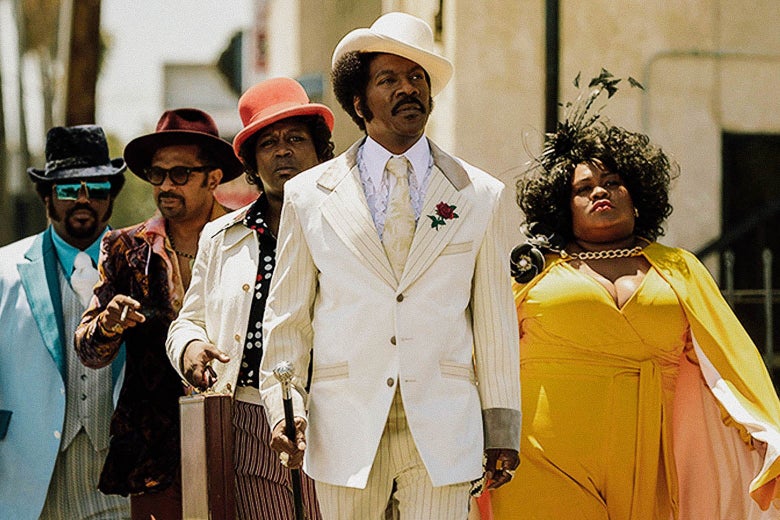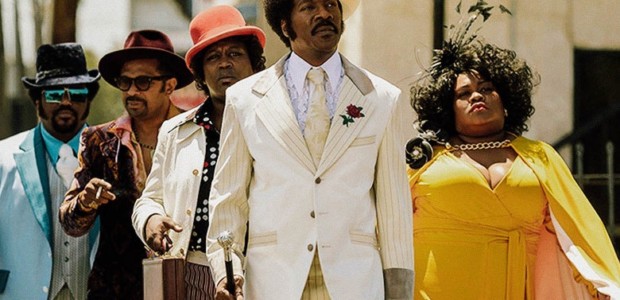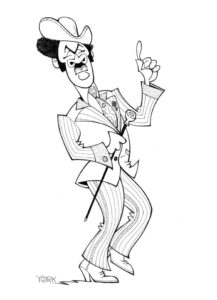There are few pleasures as pure as hearing Eddie Murphy exclaim “motherfucker,” and DOLEMITE IS MY NAME delivers just that in the opening seconds of the film—and countless times after that. DOLEMITE IS MY NAME could indeed be the film that brings Murphy back to an older audience that may have turned their back on him, as well as endear him to a generation that grew up on PLUTO NASH and DADDY DAYCARE. But what makes the film truly soar is its ensemble nature and emotional, heartfelt message about the hustle, putting in the work and believing in yourself…and your weirdo friends.

When the news broke that Eddie Murphy would be making a return to R-rated comedy portraying comedian Rudy Ray Moore, it seemed that the film could be something special. Murphy has wanted another chance at the Oscars since his DREAMGIRLS snub back in ‘07, and a biopic that would find Murphy displaying his knack for dirty comedy could be the exact vehicle—an adult comedy with an air of prestige—that the star would need to put him on that track to gold. It’s a disservice to Murphy to discredit his post-NUTTY PROFESSOR output, and to call DOLEMITE IS MY NAME a “comeback” is disingenuous. Following DREAMGIRLS, Murphy continued voicing Donkey in the SHREK sequels and appearing in Nickelodeon productions like A THOUSAND WORDS, and in 2016, the actor took a stab at a dramatic role in the tepid MR. CHURCH. He may not have been delivering the sort of comedy that a generation grew up with in BEVERLY HILLS COP, TRADING PLACES, and COMING TO AMERICA—films with copious amounts of the word “fuck”–but his films aimed towards family audiences have developed their own fan base in the ensuing years. Say what you will about NORBIT, but that thing was a hit, making twice its budget and garnering a nine-page spread in Rick Baker’s new book on movie makeup.
Murphy was introduced to the comedy of Rudy Ray Moore through his older brother Charlie, and Moore sat alongside Richard Pryor and Elvis Presley as inspiration to Murphy as he was starting out. The career of Rudy Ray Moore offers a fascinating mirror image to that of Eddie Murphy: Both men tried their hand at everything under the showbiz umbrella—comedy, singing, acting—but while Murphy found success at a very early age, Moore—despite some close brushes—didn’t find true success until his forties. In an interview with Access Hollywood, Murphy notes that the only thing he ever had to audition for was Saturday Night Live, and from then on, everything just fell into place for him. With SNL, Murphy burst into the homes of white America like a force of nature, playing Mr. Robinson, Buckwheat, and Velvet Jones every Saturday night. Moore remained a cult figure, largely only recognized by black audiences despite the success of his records and films. DOLEMITE IS MY NAME should lead to a rediscovery of Moore outside that cross-section of black audiences and exploitation enthusiasts.
Before finding success as a comedian and filmmaker, Moore lived several different lives. At 15 he was performing and dancing in black-and-tan clubs. Then he was a preacher in Milwaukee, then he served in an entertainment unit of the U.S. Army in Germany, and he recorded rhythm and blues songs for labels throughout the ‘50s and ‘60s. Eventually, life found Moore behind the counter at the Dolphin’s Of Hollywood record store in Los Angeles, where one of the locals—a man by the name of Rico—who frequented the store would recount the obscene tales of a pimp by the name of Dolemite. The stories were told in a sing-song style that would influence Moore’s comedy stylings; legend has it that Moore invited Rico over to his place, got him drunk and got him high, and recorded the wild adventures of Dolemite that would inspire and influence Moore’s act.
In 1970, Moore unleashed the raunchy party record Eat Out More Often. Moore had released three comedy albums prior to that—Below The Belt (1959), The Beatnik Scene (1962), and A Comedian Is Born (1964)—but with the opening track on Eat Out More Often, Moore introduced the character of Dolemite to the world. Kicking things off with a jazzy piano groove, Moore announces that he’s going to tell you about a “bad mother fucker called Dolemite.” On the record, Moore doesn’t tell jokes or spout one-liners, instead coming off as an X-rated beat poet rhyming raunchy stories over music. For this reason, the comedian is still heralded as “The Godfather Of Rap,” and would go on to appear on albums from Bigg Daddy Kane and 2 Live Crew. In the liner notes to a 2006 reissue of the DOLEMITE soundtrack, Snoop Dogg wrote, “without Rudy Ray Moore, there would be no Snoop Dogg, and that’s for real.”
Eat Out More Often was self-distributed through Moore’s label Comedians, Inc. and was pressed for free by Kent Records as “a favor to him as a former manager of [Dolphin’s].” Kent Records was run by Saul and Jules Bihari, who began their careers by forming the Modern label in 1945, known for R&B, country, jazz, blues, and gospel. The language and subject matter of Moore’s albums was far too raw for airplay, so Moore took a grassroots philosophy to get his record heard. He would load up his car with a trunkful of records and “go from city to city…letting people know what we had.” At Dolphin’s, Moore would play his own albums during his shifts—and legend has it, once sold 30 copies in one hour. When the Biharis realized they had a hit on their hands, they distributed the album on their Kent label. With the success of the early blaxploitation films SWEET, SWEETBACK’S BAADASSSSS SONG, COTTON COMES TO HARLEM, and SHAFT, Moore saw an opportunity, and set his sights on Hollywood. He began shopping his idea of a Dolemite feature film around to various studios around town, including Samuel Z. Arkoff’s American International Pictures. AIP got their start releasing teenage exploitation films, Edgar Allen Poe adaptations, an Beach Party movies throughout the ‘50s and ‘60s and, in the early ‘70s had garnered several blaxploitation hits, including BLACULA, BLACK CAESAR, and COFFY amongst others. However, AIP—and with every other studio in town—passed. But the Biharis, pleased with the success of Moore’s comedy albums, ponied up $30, 000 to help him bring Dolemite to the big-screen.
The original DOLEMITE was shot around Los Angeles for an estimated budget of $100,000. As seen in the biopic, Moore, ever a self starter, decided that he would make the movie himself, despite not having any filmmaking knowledge or experience. Moore put together an oddball cast of characters to help bring his vision to the screen, recruiting playwright and actor Jerry Jones to help him craft a sort of folk tale about the baddest pimp in town, Dolemite. In the director’s chair was D’Urville Martin, a relatively successful character actor who had been lured into the project by every actor’s dream: An offer to direct. Moore rounded out the cast and crew with friends, and family, as well as a handful of white boy film students including director of photography, Nicholas von Sternberg. After sitting on the shelf for years, Moore found success with DOLEMITE, again with a grassroots campaign. A screening at a single theater was a hit, which found him striking a deal with Dimension Films for distribution. DOLEMITE would go on to earn $12 million, inspiring a sequel, THE HUMAN TORNADO, as well as PETEY WHEATSTRAW, THE DEVIL’S SON-IN-LAW and DISCO GODFATHER. DOLEMITE garnered a significant place in pop culture, referenced in HOUSE PARTY, THE GREAT WHITE HYPE, and the video for Ol Dirty Bastard’s “Got Your Money,” This legacy lasted until the end of Moore’s life, and Insane Clown Posse’s BIG MONEY HUSTLAS featured his final film appearance as the character before his death in 2008.
DOLEMITE IS MY NAME is a synthesis of Murphy’s bawdy films of the ‘80s and the family-friendly output that the comedian has been cranking out since the ‘90s, with a genuine sweetness in its DNA. Thanks to the inspired recruiting of Scott Alexander and Larry Karaszewski, the writers behind 1994’s ED WOOD, it never feels like the filmmakers are making fun of Moore, his friends or DOLEMITE, despite some of the amateurish acting and filmmaking that is present in the original 1975 film.The story of Moore and his friends finding success despite the odds is one that is timeless. Murphy noted in a recent interview that he had been working on getting DOLEMITE made for years, and was excited to find out that the scribes were also tremendous fans of Moore as a filmmaker. Like ED WOOD, DOLEMITE IS MY NAME showcases a group of weirdos hellbent on creating something and, in hindsight, creating a legacy that they couldn’t have even comprehended in the moment. Say what you will of Moore’s acting chops or literal karate chops, the man could talk. He was a natural-born leader, a Pied Piper of weirdos, and his crew would follow him into the gates of independent movie hell making DOLEMITE. Moore, like Ed Wood and so many exploitation filmmakers before him, was an outsider artist who did things his own way and unwittingly inspired generations to come. Ruth Carter’s costumes, the music, and the locations—scouted out by Beyond Yacht Rock’s David B. Lyons—paint a picture of Los Angeles in the 70s with an attention to period detail reminiscent of this year’s ONCE UPON A TIME…IN HOLLYWOOD. That’s true even though the film takes some liberties with history; as Dolemite enthusiasts will be sure to point out, two of the scenes being shot in the film actually appear in 1976’s THE HUMAN TORNADO. One thing the filmmakers really did nail, though, was the ever-present boom mic in the shot.
As wonderful as it is to see Murphy portray a roomful of characters on screen, director Craig Brewer allows Murphy to sit back from all the heavy lifting at times, giving the ensemble cast a chance to shine. Wesley Snipes chews up the wood-paneled scenery as the egotistical Martin, Mike Epps does his Mike Epps shtick (a shtick that works) as Moore’s friend Jimmy Lynch, and Titus Burgess brings an understated sense of humor and heart to his performance as Theodore Toney. While the film never shines a spotlight on Moore’s progressive sensibilities (transgender actress and activist Lady Java appeared in Moore’s HUMAN TORNADO), you get a sense for it in Murphy’s interactions with Burgess, and with Da’Vine Joy Randolph as Lady Reed, Moore’s go-to leading lady who, in one of the films most touching moments, thanks Murphy’s Moore for putting someone like her on the big screen.
Murphy does shine through every time he’s on-screen, though. Since his heyday in the ‘80s, Murphy has had intangible star power. Even if he does come off as nervous in some of his early interviews, he comes alive when he performs. While Murphy, like Moore, always strived to be a rock star or a leading man, his talent for comedy is undeniable, and DOLEMITE IS MY NAME finds Murphy back in the “Mr. Fuck You Man” groove that skyrocketed the comedian to success in the ‘80s and ‘90s, but with a maturity and even humility that he hasn’t displayed on screen since COMING TO AMERICA. Murphy put in the work, hacking it out at clubs and Chinese restaurants throughout the ‘70s, but there’s something in his blood: when it comes to comedy, he’s a natural. That easygoing charm comes through in his performance as Moore, a charming man in his own right. (He had to be to convince all these people that he knew what he was doing, after all.) Murphy never truly disappears into the persona of Moore—he’s still very much Eddie—but everything around him brings an authenticity to the character. Murphy captures the essence of Moore.
DOLEMITE IS MY NAME is sure to entertain those that grew up with Eddie Murphy, whether you first discovered him with DELIRIOUS or have grown up with him from NASH PLUTO on. It is undeniably funny, touching, and inspiring, and offers Murphy a chance to reflect on his own career and legacy as a superstar by portraying a luminary who helped pave the way for his success. The film will hopefully lead to a whole new generation to become Murphy fans, as well as fans of Rudy Ray Moore. A longtime fan himself, Murphy has been trying to bring this project to the screen for over a decade, and like Moore himself, Murphy’s tenacity paid off.
—MIKE VANDERBILT
- Vampsploitation - January 15, 2018
- Hiatussploitation - December 5, 2017
- Live From Fantastic Fest, 2017 - September 28, 2017
Tags: Craig Brewer, Dolemite, Dolemite Is My Name, eddie murphy, Rudy Ray Moore



No Comments